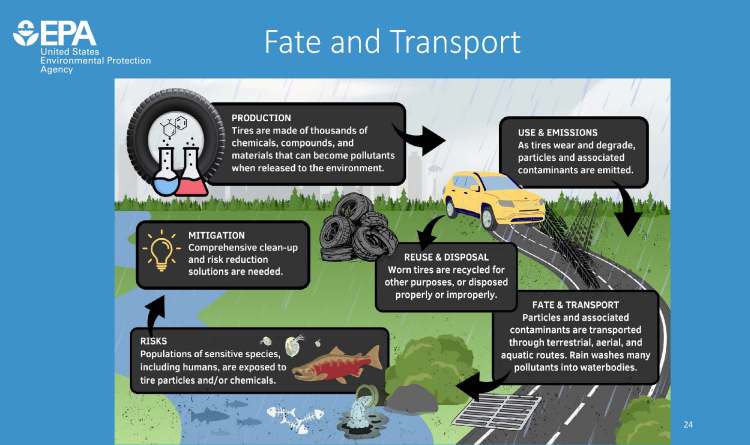About the EPA:
 For some people, tire pollution may conjure up the image of a worn out or discarded tire on the side of the highway, or a pile of old tires behind a garage. However, the issue of tire pollution is more complex and widespread than meets the eye, as every stage of a tire’s life cycle, from production to use to disposal , you can affect our environment, health and wildlife.
For some people, tire pollution may conjure up the image of a worn out or discarded tire on the side of the highway, or a pile of old tires behind a garage. However, the issue of tire pollution is more complex and widespread than meets the eye, as every stage of a tire’s life cycle, from production to use to disposal , you can affect our environment, health and wildlife.
To address the growing problems of tire pollution and a specific pollutant called 6PPD-quinone (6PPD-Q), EPA researcher Dr. Paul Mayer led the effort to investigate the life cycle of tires and their effects on the environment. The article, “Where the Rubber Meets the Road: Environmental Impacts of Tire Particles and Their Chemicals,” is a comprehensive analysis and compilation of data on tires as a complex waste across the spectrum. three: their whole state (for example, tire production or disposal in landfills), as particles (that is, when they are finished), and as “chemical cocktails .”
A team of researchers has shown that the production of more than 3 billion tires each year requires a lot of natural resources, including fuel, water and agricultural land to grow natural rubber, which has been associated with deforestation. The manufacturing process involves chemical compounds that produce carcinogens (cancer-causing substances) and radioactive compounds. More than 800 million tires are discarded each year and are burned for fuel or shredded and recycled into products such as artificial turf, asphalt, landscape mulch and door mats. These methods can present hazards such as contact with chemicals and heavy metals, inhalation, ingestion, and other hazards associated with crumb wheels. In addition, piles of tires can catch fire and burn for a long time, releasing harmful pollutants such as fine particulate matter (PM2.5).

Researchers have found that a single tire will shed between two and fourteen pounds of rubber particles due to road wear (from initial use to disposal). These particles may be small enough to be picked up by the wind and carried for up to a month before being deposited on the ground. Larger particles can be picked up by stormwater and carried along curbs and through stormwater systems where they are often discharged into local waterways. Particles of these particles, pollutants such as microplastics, heavy metals, hydrocarbons, and other toxic chemicals can then contaminate local water and soil.
The researchers also analyzed the life cycle of rubber tires, following one product from creation to disposal, to identify information gaps in research related to tires on the road. The rate and size of the release of tires can vary between tire types and brands. The size, shape and surface quality of tires can affect their handling and handling. More research is also needed to characterize the toxicity of tire pollutants and their health effects, including identifying other chemicals to be used in manufacturing and conducting studies. a long time in terms of species that do not care. More accurate data on tire emissions and chemicals based on climate, population, and transportation patterns are needed to support the development of effective methods to reduce tire pollution, remediate , and risk management. These information gaps and many others identified by the research team indicate that tire particles and chemicals pose a serious risk to human health and the environment, and that research and action should be taken. to reduce this issue.
Several research groups across the EPA are working to address information gaps directly related to 6PPD-Q contamination. 6PPD-Q is a reaction product between 6PPD, a chemical used in tire manufacturing, and ozone in the air. An EPA-funded study in 2020 showed 6PPD-Q in stormwater to be highly toxic to many salmonid fish species and killing endangered and threatened coho salmon populations. This species is an important cultural, economic, and ecological resource for many Tribal communities along the Pacific Northwest coast and its connecting waterways. Healthy and accessible salmon populations are critical to the health and well-being of generations, including the implementation and protection of Conventional Rights.
EPA environmental expert Dr. Jonathan Halama uses the advanced EPA Visualizing Ecosystem Land Management Assessments (VELMA) method to learn more about the fate and transport of 6PPD-Q from tire parts in stormwater. Through an analysis of current stormwater management systems and estimated routing methods based on traffic statistics, Halama and his team are working to understand the processes that influence wheel flow. and find hotspots where 6PPD-Q is concentrated within the watershed. Using VELMA to locate these 6PPD-Q sites can help researchers prioritize areas and types of stormwater management plans to effectively reduce 6PPD-Q levels.
In 2023, the EPA developed a method to test for 6PPD-Q in surface and storm water. In addition to tire life cycle analysis and stormwater management modeling, there are numerous research efforts within EPA and collaborations with external partners focused on 6PPD-Q. EPA researchers are developing methods for measuring 6PPD-Q in air and soil, tools for testing the toxicity of environmental samples, and criteria for assessing health risks. To further protect coho salmon and other sensitive aquatic species, researchers are investigating the emission rates of brake and tire particulates, 6PPD, and iron, the health effects of tire particulates and 6PPD-Q in aquatic life, and other chemicals that may contain 6PPD in tires. .
Learn more about Science

#EPA #rubber #meets #road #EPA #researchers #study #environmental #health #impact #tires
